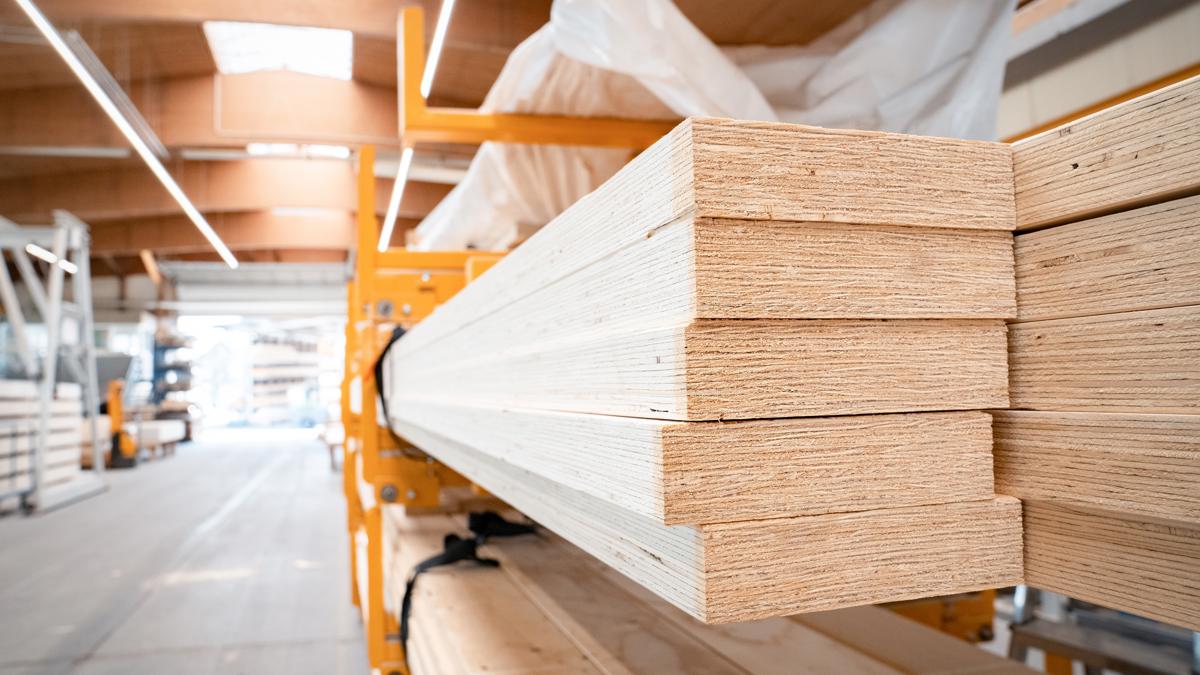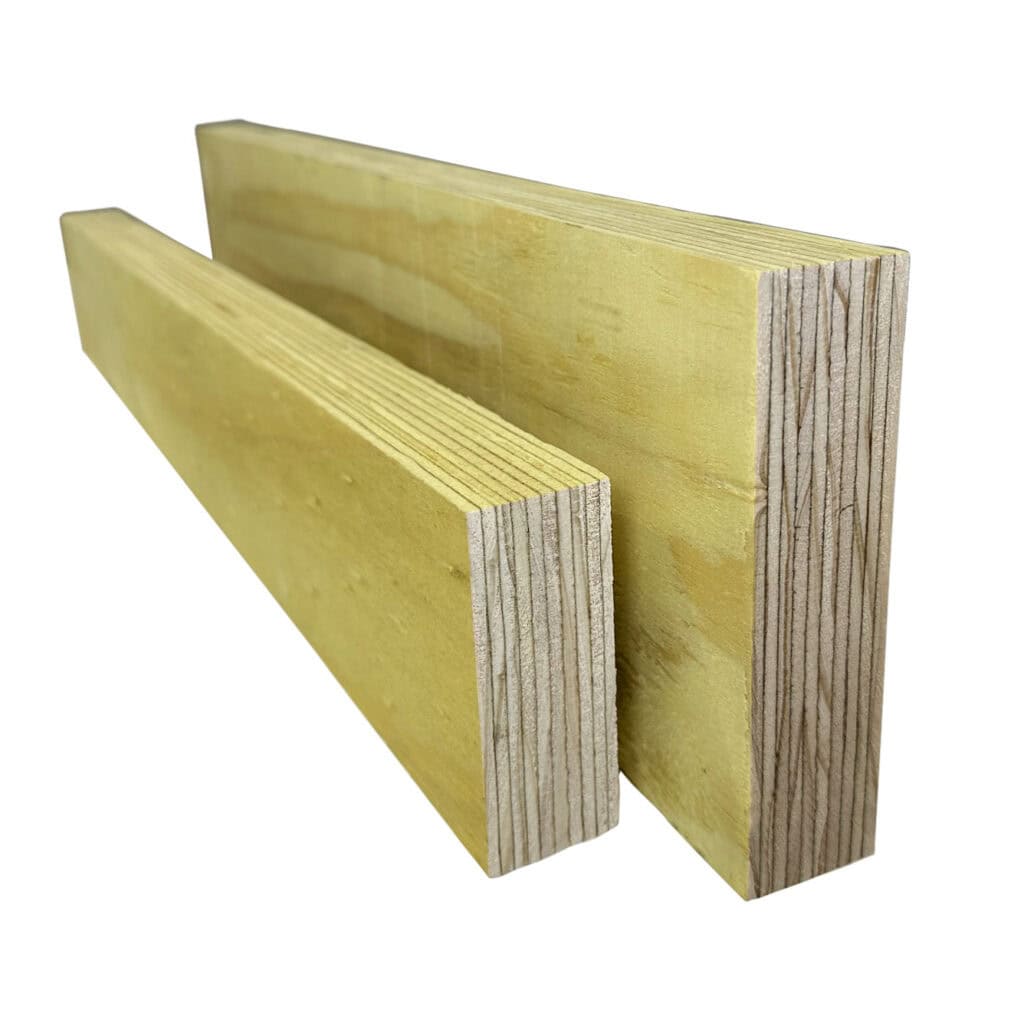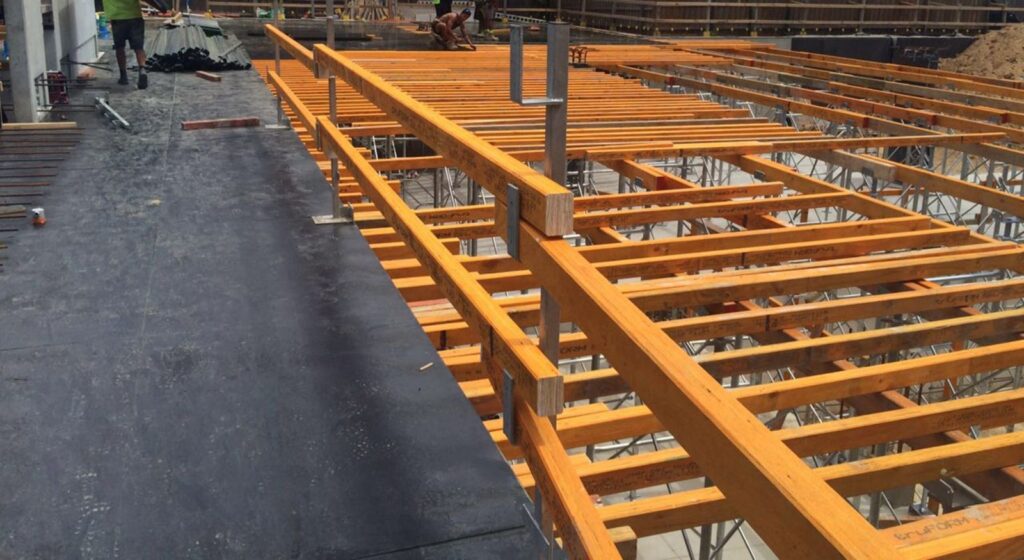
How Does LVL Formwork Compare to Traditional Timber Systems? This question is important for construction professionals looking for the best formwork solutions. LVL formwork is an engineered wood product made from thin layers of wood glued together under controlled conditions, while traditional timber systems use solid wood or plywood put together on-site.
Choosing the right LVL Formwork materials directly affects project timelines, structural integrity, and long-term costs. Making the wrong choice can result in dimensional inconsistencies, higher labour costs, and compromised safety standards.
This detailed comparison looks at:
- The manufacturing processes and material characteristics of both systems
- The differences in strength, durability, and dimensional stability
- The cost implications from initial investment to long-term performance
- The practical applications where each material performs best
- The environmental considerations that impact sustainability goals
Whether you’re working on a commercial development or a residential project, knowing these differences will help you make informed decisions about formwork materials that suit your specific construction needs and budget limitations.
What Is Laminated Veneer Lumber (LVL) Formwork and How Is It Made?
Laminated veneer lumber is an engineered wood product created by bonding multiple thin layers of wood veneer together to form a strong, uniform structural material. Unlike solid timber cut directly from logs, LVL transforms smaller wood sections into high-performance construction components through precision manufacturing.
The production process begins with rotary-peeling logs into thin veneers, typically 3mm thick. These veneers undergo careful grading and drying to achieve optimal moisture content. Manufacturers then apply low-impact, exterior-grade adhesives between layers before subjecting them to heat and pressure in specialized presses. This bonding process creates a solid beam with grain running parallel throughout its length, eliminating the natural defects found in conventional timber.
LVL properties deliver exceptional performance across multiple metrics:
- Strength-to-weight ratio: Twice as strong as steel by weight, enabling lighter structures without compromising load capacity
- Uniformity: Consistent quality throughout each piece eliminates weak spots or knots
- Dimensional stability: Engineered construction resists moisture-related movement
Plantation-grown radiata pine serves as the primary raw material for most LVL production. This fast-growing species reaches harvest maturity in 25-30 years, providing a renewable resource when sourced from certified sustainable forests. The efficient use of smaller logs reduces pressure on old-growth forests whilst maintaining structural performance that matches or exceeds traditional large-section timbers.
How Does LVL Formwork’s Strength and Durability Compare to Traditional Timber?
LVL formwork delivers exceptional strength that surpasses traditional timber in critical performance metrics. The engineered product achieves twice the strength of steel by weight, making it the superior choice for demanding applications like bearers and joists in formwork structures. This remarkable strength-to-weight ratio allows construction teams to use smaller sections whilst maintaining structural integrity, reducing material costs and simplifying handling on site.
Strength Comparison: LVL vs Traditional Timber
The strength comparison between LVL and traditional timber reveals significant advantages for engineered wood. LVL’s manufacturing process creates a product with compression strength comparable to high-performance concrete, ensuring consistent performance under heavy loads. Traditional timber often struggles with variable strength due to natural defects like knots, splits, or grain irregularities that compromise structural reliability.
Warping Resistance: A Key Benefit of LVL
Timber warping resistance represents one of LVL’s most valuable benefits. The engineered construction minimises shrinkage and expansion from moisture changes—problems that regularly plague traditional timber systems. Natural timber responds dramatically to environmental conditions, leading to:
- Warping that affects formwork alignment
- Twisting that creates gaps in concrete forms
- Shrinkage causing joint separation
- Expansion that distorts dimensional accuracy
LVL maintains its shape and dimensions throughout temperature fluctuations and varying humidity levels, delivering predictable performance across multiple uses and extending service life beyond conventional timber alternatives. This reliability is a key aspect that sets LVL apart from traditional timber.
How Is LVL More Dimensionally Stable Than Traditional Timber Systems?
LVL formwork maintains consistent dimensions throughout its service life because the manufacturing process eliminates natural wood irregularities. Each layer of veneer is carefully aligned with the grain running parallel, creating a uniform product that resists the dimensional changes that plague solid timber.
LVL uniformity stems from precise factory conditions where temperature, pressure, and adhesive application are controlled. This engineered approach produces beams and panels that stay true to their specified measurements, regardless of environmental conditions on site. Construction teams can rely on exact dimensions when planning formwork layouts and calculating load requirements.
The Dimensional Deformation Issues with Traditional Timber
Traditional timber faces significant timber deformation issues that compromise construction precision:
- Warping occurs when moisture content varies across the timber’s cross-section, causing boards to curve or bend
- Twisting happens as wood fibres dry unevenly, creating spiral distortions that make proper alignment nearly impossible
- Shrinking results from moisture loss, leading to gaps in formwork joints and potential concrete leakage
- Cupping develops when one face of a board dries faster than the other, creating concave surfaces
These deformations force contractors to spend additional time sorting through timber stocks, rejecting unsuitable pieces, and making on-site adjustments. Dimensional stability in LVL eliminates these delays, allowing formwork systems to be assembled quickly with confidence that components will fit together precisely and maintain their shape under load.
How Do Cost Considerations Between LVL Formwork and Traditional Timber Systems Compare?
Traditional timber formwork typically costs less upfront, making it attractive for projects with tight initial budgets. Standard solid timber or plywood sheets remain widely available at competitive prices, particularly for smaller-scale construction work. The cost comparison LVL vs timber formwork reveals that LVL products command a premium at purchase, often 20-40% higher than conventional timber alternatives.

The true economic picture emerges when examining upfront cost vs lifecycle cost over multiple projects. Traditional timber deteriorates faster under repeated use, requiring frequent replacement after 5-10 pours depending on conditions. Warping and moisture damage force contractors to discard sections prematurely, generating ongoing material expenses. Click here to learn about top 5 reasons builders choose Formply for large-scale projects
LVL formwork delivers superior value through extended service life, often lasting 50-100 pours with proper handling. The engineered structure resists moisture-related degradation, maintaining dimensional accuracy across numerous concrete placements. This durability translates to:
- Reduced replacement frequency lowering long-term material costs
- Fewer site delays from formwork failure or adjustment needs
- Minimal waste disposal expenses
- Consistent performance eliminating costly concrete defects from formwork movement
Labour savings amplify LVL’s economic advantages. The lighter weight and dimensional consistency speed installation and stripping operations, reducing crew hours per pour. Projects requiring precision benefit most, as LVL eliminates time spent correcting warped or twisted timber sections that compromise concrete quality.
What Are The Common Applications Where LVL Formwork Excels Over Traditional Timber?
Applications where LVL formwork excels over traditional timber include structural components requiring precise dimensional control and extended spans. The engineered product’s uniformity makes it the preferred choice for bearers and joists in formwork structures, where even minor variations could compromise concrete placement accuracy.
1. Longer Continuous Lengths
LVL’s ability to be manufactured in longer continuous lengths—often exceeding 15 metres—eliminates the need for multiple joints that weaken traditional timber systems. This extended span capability proves invaluable in:
- Walers and soldiers for wall formwork requiring uninterrupted support
- Edgeboards demanding straight, true edges for clean concrete finishes
- Horizontal beams spanning large distances without intermediate supports
- Repetitive formwork systems where consistency across multiple pours is essential
2. High-Rise Construction Projects
High-rise construction projects particularly benefit from LVL’s dimensional stability, as temperature fluctuations and humidity changes at elevation can cause traditional timber to warp or twist. The engineered product maintains its shape and strength across varying site conditions, ensuring formwork remains plumb and level throughout extended construction schedules.
Do The Practical Benefits Of Using LVL On Construction Sites Outweigh Those Of Traditional Timber?
Yes, LVL delivers superior on-site performance through reduced labour demands and enhanced safety protocols. The lighter weight of LVL formwork translates directly into faster installation times, with crews able to manoeuvre components without heavy lifting equipment that traditional timber often requires.
Construction efficiency LVL systems demonstrate measurable time savings:
- Single workers can handle LVL panels that would typically require two-person teams with conventional timber
- Reduced installation time accelerates project schedules by up to 20% in formwork-intensive applications
- Precision-cut dimensions eliminate on-site trimming and adjustment delays
Fire resistance represents a critical safety advantage. LVL’s engineered structure provides predictable charring rates during fire exposure, maintaining structural integrity longer than traditional timber. This characteristic allows construction teams to implement more reliable fire safety protocols, particularly in multi-storey concrete pours where formwork remains in place for extended periods.
The combination of how does LVL formwork compare to traditional timber systems becomes evident through reduced insurance premiums and fewer work stoppages due to safety concerns. Site managers report fewer handling-related injuries and improved workflow coordination when using LVL components.
Is The Environmental Impact Of Using LVL Formwork More Favourable Compared To That Of Traditional Timber Systems?
LVL formwork significantly reduces environmental impact by eliminating the need for large, old-growth timber sections. The engineered manufacturing process transforms smaller plantation-grown radiata pine veneers into high-performance structural elements, making efficient use of renewable forest resources.
Sustainable formwork practices favour LVL for several environmental reasons:
- Resource efficiency: LVL utilises smaller diameter logs from managed plantations rather than requiring mature forest trees
- Manufacturing precision: The controlled production process minimises material waste during fabrication
- Extended service life: Superior durability means fewer replacements, reducing cumulative resource consumption
Traditional timber formwork generates considerable waste through cutting, sizing, and eventual disposal after limited reuse cycles. Solid timber sections often end up in landfills when damaged by moisture, warping, or splitting.
LVL’s dimensional stability allows multiple reuse cycles without performance degradation. When responsibly sourced from certified forests and manufactured using low-impact adhesives, LVL formwork delivers measurably lower environmental footprint across its lifecycle compared to conventional timber alternatives.

Conclusion
How does LVL formwork compare to traditional timber systems? LVL delivers superior strength, dimensional stability, and long-term cost efficiency that traditional timber simply cannot match. The engineered precision of laminated veneer lumber eliminates the warping and shrinkage issues that plague conventional materials whilst offering twice the strength-to-weight ratio of steel.
For construction projects demanding reliability and performance, LVL formwork represents the smarter investment. Its sustainable sourcing from plantation-grown timber, reduced waste generation, and exceptional durability make it the clear choice for modern building ventures. The initial cost premium pays dividends through extended service life, minimal maintenance requirements, and consistent structural integrity.
Ready to upgrade your formwork systems? Contact your local LVL supplier today to discuss how engineered wood solutions can transform your next construction project with proven performance and environmental responsibility.
FAQs About LVL Formwork vs. Traditional Timber Systems
LVL (Laminated Veneer Lumber) formwork is an engineered wood product made by bonding thin wood veneers under heat and pressure. This process creates a strong, uniform material that eliminates defects like knots and grain irregularities found in traditional timber, resulting in superior strength and dimensional stability.
LVL formwork differs in both composition and performance. While traditional timber relies on solid wood or plywood assembled on-site, LVL is factory-engineered for precision, offering consistent strength, reduced warping, and longer lifespan.
Yes. LVL formwork has an exceptional strength-to-weight ratio—twice as strong as steel by weight—making it stronger and more reliable than conventional timber. This strength ensures better load-bearing capacity and minimizes deformation under pressure.
Because LVL is engineered under controlled conditions with all wood grains aligned in the same direction, it resists shrinking, swelling, and warping caused by moisture and temperature changes. Traditional timber, being a natural product, is prone to such movements.
Initially, LVL can cost 20–40% more than solid timber. However, its longer service life, minimal waste, and reduced replacement frequency make it more cost-effective in the long term, especially for large or repetitive concrete projects.
Faster installation due to lighter weight
Greater precision and fewer adjustments
Reduced labour costs
Better fire resistance
Lower risk of injury from manual handling
These benefits improve both productivity and safety on construction sites.
